Tourism & The End Of Sacred Space
In a recent trip to China's Zhangjiajie National Park (the filming location of blue people 'Avatar') I accompanied some Chinese friends on a tour of the largest mountain I have ever seen (Tianmen Mountain). The sheer size and steepness of the mountain was beyond anything I had imagined. Near the top, we passed through "the gate of Heaven;" an enormous iconic hole leading through the rocky cliffs.
The mountain is ancient and well known to hundreds of generations of Chinese people who have lived, worked, and died under its imposing walls. A Tang Dynasty (AD 618-907) Buddhist monastery was built on the huge upper plateau, and the mountain was once considered sacred.
As we climbed, I could imagine a solitary wisdom seeker embarking on a days or weeks long effort to summit the holy peaks in search of guidance or enlightenment. It must have been inspiring for them to pass through the misty forests and clefts thousands of feet above their countrymen. Atop this mountain a holy man could certainly find solitude; only the truly committed would reach him for guidance and wisdom.
But all this is lost in the past. My friends and I scaled the mountain in a few hours and voluntarily chose to climb the 999 steps to Heaven's Gate (天門山). Our greatest challenge was walking over terrifying "invisible" glass bridges. A cable car took us down the mountain in fifteen to twenty minutes.
I realized the mountain had lost much of the sacred relevance it once possessed. Tourism and development had rendered the site accessible… too accessible. There was rarely a moment when our group was alone. Normally, hundreds or thousands of people surrounded us. At the monastery, I talked to a photographer from Poland who joked about the recent reconstruction of the temples following the Cultural Revolution. Turns out, the monastery buildings, though built to look old, were younger than I was.
The trip reminded me of how anti-sacred the modern world has become. Everything that can has been monetized and democratized for tourism. Modernity acknowledges no sacred space. Everything has become a quaint imitation of what was once actually believed. We are only capable of reenacting a holy mountain pilgrimage in a crude half-day tour that strips the meaning out of meditation and journey.
Mountains were once physical manifestations of spiritual archetypes; meeting places between heaven and earth. A descent into a cave once represented a person's connection with the underworld. Physical places used to become spiritually meaningful through human interaction. Today, mountains (even spectacular ones) and caves are little more than an excuse to take #adventure Instagram selfies.
The physical world in the twenty-first century has lost spiritual significance.
